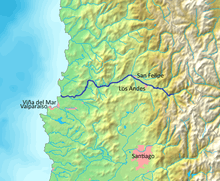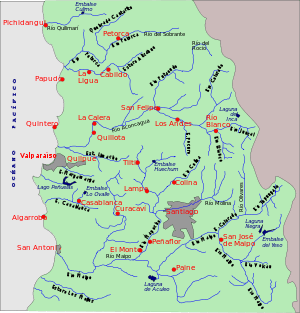Aconcagua River
| Aconcagua River | |
|---|---|
 | |
| Country | Chile |
| Basin | |
| Main source | 1,430 m (4,690 ft)[1] |
| River mouth | Pacific Ocean |
| Basin size | 7,340 km2 (2,830 sq mi)[1] |
| Physical characteristics | |
| Length | 142 km (88 mi)[1] |

The Aconcagua River is a river in Chile that rises from the conflux of two minor tributary rivers at 1,430 metres (4,690 ft) above sea level in the Andes, Juncal River from the east (which rise in the Nevado Juncal) and Blanco River from the south east. The Aconcagua river flows westward through the broad Aconcagua valley and enters the Pacific Ocean 20 kilometres (12 mi) north of Valparaíso.[2]
The river has a course of about 142 kilometres (88 mi), and its waters irrigate the most populous sections[2] of the Chilean provinces of San Felipe de Aconcagua and Los Andes, being the most important economic resource of those regions. During the course of the Aconcagua river, it receives contributions from many others rivers and swamps, reaching a mean flow of 39 cubic metres per second (1,400 cu ft/s).
The Aconcagua River valley was used as the route of the Transandine Railway on the Chilean side. The river flows alongside Chile Route 5 from Llaillay to La Calera. For much of their lengths, the two separate stretches of Chile Route 60 follow the course of the river.
Although it has the same name, the Aconcagua river does not rise in the slopes of Aconcagua, which is entirely in Argentina about 20 kilometres (12 mi) from the beginning of the river, in Chilean territory.
Tributaries
- Colorado River
- Estero Pocuro
- Putaendo River
- Estero Quilpué
- Estero Catemu
- Estero Los Loros
- Estero Los Litres
- Estero Limache
References
- 1 2 3 "Cuenca del Río Aconcagua". Diagnóstico y Clasificación de los Cursos y Cuerpos de Agua según Objetivos de Calidad. Dirección General de Aguas. 2004. Retrieved 14 February 2013.
- 1 2
 Chisholm, Hugh, ed. (1911). "Aconcagua". Encyclopædia Britannica. 1 (11th ed.). Cambridge University Press. p. 151.
Chisholm, Hugh, ed. (1911). "Aconcagua". Encyclopædia Britannica. 1 (11th ed.). Cambridge University Press. p. 151.
- Niemeyer, Hans; Cereceda, Pilar (1983), Geografía de Chile — Tomo VIII: Hidrografía, 1º edición, Santiago de Chile: Instituto Geográfico Militar.
- Gobierno de Chile, Ministerio de Obras Públicas, Dirección General de Aguas (2004) Cuenca del Río Aconcagua, Diagnóstico y Clasificación de los Cursos y Cuerpos de Agua Según Objetivos de Calidad
External links
| Wikimedia Commons has media related to Aconcagua River. |
Coordinates: 32°54′54″S 71°30′30″W / 32.91500°S 71.50833°W